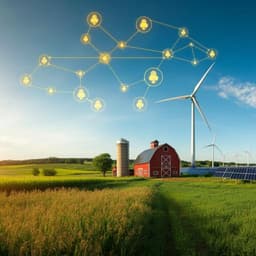
Environmental Studies and Forestry
Research on regional differences of the impact of clean energy development on carbon dioxide emission and economic growth
W. Jia, X. Jia, et al.
This research by Weiping Jia, Xianwen Jia, Ling Wu, Yanbing Guo, Teng Yang, Ermei Wang, and Pan Xiao dives into the intricate relationship between clean energy development, carbon dioxide emissions, and economic growth across China's diverse provinces. The study highlights significant regional variations, unveiling challenges and opportunities for effective clean energy strategies in the quest for environmental sustainability and economic advancement.
~3 min • Beginner • English
Introduction
China’s rapid industrialization and urbanization since 1979 have driven substantial GDP growth but also heavy reliance on fossil fuels and escalating CO2 emissions. Recognizing the environmental challenges, Chinese authorities have increasingly invested in clean energy development (CED). However, significant regional differences exist in industrial structure, resource endowment, technology, and urbanization across eastern, central, and western China, implying potential heterogeneity in CED’s impacts. This study asks: (1) What is the role of CED in reducing carbon dioxide emissions (CDE)? (2) Can CED promote economic growth despite requiring large investments? It investigates linear and nonlinear effects of CED on both CDE and economic growth, accounting for regional disparities across 30 provinces, using data from 1979–2016 and forecasts for 2017–2030.
Literature Review
Prior research links clean energy to both emissions and growth, with mixed findings. Some studies argue expanding clean energy through fiscal incentives reduces CDE and optimizing energy structure helps control emissions. Causality tests often find CE reduces CDE, though panel VAR evidence from some regions reports insignificant effects. On growth, studies suggest CED can upgrade industrial structure and support long-run growth, though it may raise energy prices and dampen short-run activity; panel models indicate cointegration and potential bidirectional causality between CE consumption and growth. Gaps include predominant linear modeling that overlooks complex nonlinear relationships among economic variables and macro-level analyses that may mask regional heterogeneity. This study contributes by using a non-parametric additive framework at the provincial level to capture nonlinearities and regional differences in China.
Methodology
The study adopts a non-parametric additive regression framework to model potentially nonlinear relationships while mitigating the curse of dimensionality. The additive model augments linear terms with smooth non-parametric functions and is estimated via backfitting. Economic growth model: Building on the Solow production function Yt = At Kt^α Lt^β, the authors incorporate clean energy (CE) and urbanization (URB). The empirical panel specification uses logs: LGDP_it = C + β1 LTEC_it + β2 LCAP_it + β3 LLAB_it + β4 LCE_it + β5 LURB_it + g1(LTEC_it) + ... + g5(LURB_it) + μ_it, where TEC is technological progress, CAP capital stock, LAB labor input, CE clean energy production capacity, URB urbanization rate; gj(·) are non-parametric functions. CDE model: Extending the IPAT/STIRPAT framework, the log-linear base is LCO2_it = C + β1 LPOP_it + β2 LGDP_it + β3 LEI_it + β4 LCE_it + β5 ENS_it + β6 LER_it + μ_it, then augmented non-parametrically as LCO2_it = C + linear terms + g1(LPOP_it)+...+g6(LER_it)+μ_it. Variables: - Economic growth (LGDP): real per capita GDP (deflated by per capita GDP deflator). - CE (LCE): provincial total energy production multiplied by the share of clean energy (hydro, nuclear, wind, geothermal, etc.) in total energy production (100 million kWh). - URB: urban population share. - LAB: number of employees. - CAP: capital stock via perpetual inventory method. - TEC: total factor productivity via Malmquist index. - CDE (LCO2): calculated as fossil energy consumption (coal, oil, natural gas) in tons of standard coal times CO2 emission factor (2.70 tCO2 per ton of standard coal). - POP: total population. - EI: energy intensity (energy consumption/GDP). - ENS: energy consumption structure (coal share of total energy consumption). - ER (LER): environmental regulation index (unit emissions of SO2 and dust/smoke). Data: Panel of 30 provinces, 1979–2016 observed; 2017–2030 forecast. Sources: China Statistical Yearbook, provincial yearbooks, China Energy Statistical Yearbook. Forecasting: ARIMA for relatively stable indices (per capita GDP deflator, TFP index, fixed asset investment price index); double exponential smoothing for trending variables (per capita GDP, CE production, total energy consumption, industrial output, environmental regulation, employment, etc.). Validation shows high fit of forecasts versus observed for 1979–2016. Endogeneity: Tested CE exogeneity. For growth model (Eq. 6), Durbin–Wu–Hausman test accepts exogeneity (p=0.99). For CDE model (Eq. 9), EHR weak exogeneity test F(1,1447)=3.79, p=0.0516 accepts exogeneity at 5%. Model fit and robustness: Compared residual sums of squares (RSS) between additive and linear panel models; additive model shows substantially lower RSS across regions for both outcomes. Robustness checks include: (i) using GDP instead of per capita GDP for growth; (ii) using nominal per capita GDP in CDE model. Signs and significance patterns remain consistent, supporting robustness.
Key Findings
- Linear effects on economic growth: Clean energy development (CED) shows negative linear coefficients across regions, suggesting, on average, CED hinders growth likely due to high upfront investment and fiscal supports. From Table 2 (linear part of the additive model): East −0.109 (ns), Central −0.011 (10%), West −0.077 (1%). - Nonlinear effects on economic growth: Regionally heterogeneous patterns (Fig. 1): East: W-shaped relationship; initial hindrance due to capital-intensive investments and fiscal burdens, mid-term fluctuations with external shocks, long-run promotion as scale and cost reductions emerge. Central: gentle W-shaped; little effect early, limited mid-term, positive in later stage as scale and competitiveness improve. West: inverted U-shaped; early promotion due to abundant hydropower lowering costs, waning contribution later as growth relies more on technological progress and energy cost share declines. - Linear effects on CDE (Table 3): Clean energy coefficients are positive and significant but small (East 0.012***; Central 0.074***; West 0.077***), indicating that, linearly, CED has not significantly reduced CDE given small CE scale and faster fossil growth. Other drivers: Economic growth, energy intensity, and coal-heavy energy structure increase CDE; environmental regulation decreases CDE; population generally increases CDE (region-dependent significance). - Nonlinear effects on CDE (Fig. 2): East: M-shaped relationship; limited early reduction effect, mid-term fluctuation with energy price dynamics, notable long-run reduction as CE scales up. Central: gentle W-shaped; early reductions via hydropower, weaker later as energy demand outpaces CE and hydropower potential is limited. West: U-shaped; early reductions due to abundant hydropower substituting fossils, diminishing effect later as total energy demand growth overtakes CE expansion. - Model performance: Additive model substantially outperforms linear panel model in RSS for both outcomes and all regions (e.g., CDE East RSS: linear 33.940 vs additive 8.627; Growth East RSS: linear 79.623 vs additive 8.607). - Endogeneity: Tests indicate CE is exogenous in both growth and CDE models at 5% level. - Robustness: Results hold when substituting GDP for per capita GDP and when using nominal per capita GDP in the CDE model.
Discussion
The study’s findings address the core questions by showing that simple linear relationships mask substantial nonlinear and region-specific dynamics. Linearly, CED neither reduces CDE nor promotes growth significantly, reflecting the current small share of clean energy and the high initial investment and fiscal burden. However, the nonlinear analyses reveal phase-dependent effects: as CE scales and costs decline, CED can support emissions reduction (notably in the east) and promote growth (east and central in later stages), whereas regions rich in hydropower (west) benefit early but see diminishing marginal effects later as technological progress and broader structural changes dominate. These insights underscore the importance of regionalized, phase-sensitive policy: strengthening environmental regulation continues to be effective in lowering CDE, while fostering technology and scaling CE can transition CED from short-run drag to long-run driver of green growth.
Conclusion
Using a non-parametric additive regression model on provincial panel data (1979–2016 observed; 2017–2030 forecast), the study concludes: (1) Linear estimates suggest CED has not yet reduced CDE and tends to hinder economic growth due to large upfront investment and fiscal incentives. (2) Nonlinear, region-specific effects are pronounced. For CDE: East shows an M-shaped path with long-run reductions; Central shows a gentle W-shaped pattern with early benefits and later attenuation; West shows a U-shaped pattern with early reductions eroded by rising total energy demand. For growth: East exhibits a gentle W-shaped relation (late-stage promotion), Central a gentle W-shaped (late-stage promotion), and West an inverted U-shaped (early promotion, later decline). Policy recommendations: - East: Expand and scale CE to accelerate the long-run CDE reduction; use targeted incentives early, then pivot to market mechanisms to avoid fiscal burdens. - Central: Expand CE supply, especially beyond limited hydropower; reduce fossil dependence through diversified CE and cost reductions; support scaling of producers. - West: Increase CE consumption to curb rising fossil use; complement hydropower with other CE; focus on technological innovation and talent to sustain growth as energy cost share declines. Overall, strengthen environmental regulation, guide markets to expand CE consumption, and tailor policies to regional resource endowments and development phases.
Limitations
- Data for 2017–2030 are forecasted (ARIMA and double exponential smoothing); although validated against historical data, projections introduce uncertainty. - Non-parametric estimates can be sensitive to data changes and bandwidth choices, potentially affecting curve shapes; robustness checks mitigate but do not eliminate this concern. - CE measure is based on production capacity and share within total energy production; differences between production and consumption, grid integration constraints, and curtailment are not explicitly modeled. - Regional aggregation (east/central/west) may hide intra-regional heterogeneity. - Potential unobserved policy or market shocks beyond the modeled variables may influence results.
Related Publications
Explore these studies to deepen your understanding of the subject.







